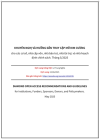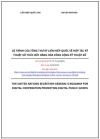


In her fourth post in a short series, Anne Young helps you navigate the different types of licensing schema GLAMs might implement. Read the first, second, and third post. Next week Anne will dive deep into implementing Open Access at your institution!
A Stag at Sharkey’s (detail), 1917, lithograph, 18–5/8 x 23–7/8 in. Indianapolis Museum of Art at Newfields, Gift of Mrs. George Ball, 26.5. Public Domain.
As we’ve seen in previous posts, GLAM institutions must have sound Rights and Reproductions (R&R) policies and procedures set for individually processing requests BEFORE they can institute Open Access. I would bet dollars to donuts that most GLAMs have some content that cannot be made available under Open Access.
R&R policies and procedures for requests can broadly follow one of several approaches to granting access to collection content, traditionally predicated on licensing in some way, but may also include Open Access. GLAMs can utilize one or more of these approaches depending on the various intellectual property rights of its collections.
Option 1. GLAMs may license collection content when they hold the intellectual property rights to the content or have a non-exclusive licensing agreement on file that permits sub-licensing.
Option 2. GLAMs may provide access to collection content only when the party requesting the use has previously and independently received permission from the intellectual property rights holder(s).
Option 3. GLAMs may provide either full Open Access or a “Semi-Open Access” (i.e., restrictions on some uses, but broadly open to research, scholarly publications, etc.) to only collection content that is clearly in the Public Domain.
Option 4. GLAMs may enable the licensing of all collection content (whether in the public domain or still under copyright or other intellectual property rights) and explicitly state that all rights clearance and permissions work is the responsibility of the requesting party.¹
Self-Portrait (detail), about 1629, oil on panel, 17–1/2 × 13–1/2 × 3/4 in. (panel). Indianapolis Museum of Art at Newfields, Courtesy of The Clowes Fund, C10063. Public Domain.
The first three options are the least risky for GLAM institutions, but can mean that large parts of collections are inaccessible. The fourth option allows access to all the collection, but the GLAM needs to carefully outline rights clearance responsibilities of the requesting party in a licensing contract to limit the liability of the GLAM by association to a third-party use of their collection content.
Once a GLAM has determined which approach(es) they will utilize to share and license their collections (we’ll get into the Open Access opportunities more in our next post), they can put procedures into place for processing these requests in a timely and efficient manner.
Depending on the approach(es) selected, there are five more questions for GLAMs to consider internally when implementing licensing procedures.
Question 1. “Does the request meet the GLAM’s policy on permitted uses?”
Question 2. “What rights to license the content does the GLAM hold?”
Question 3. “Is the GLAM content in the public domain?”
Question 4. “If the content is under copyright, is there a non-exclusive license for the content that permits sub-licensing to a third party for the requested use?”
Question 5. “If the content depicts sensitive content (think of the “other” considerations previously mentioned) does the request meet the GLAM’s policy about distribution of the content?”²
Once a GLAM has determined the policy approach(es) to take and answered the additional questions for licensing procedures, they can develop request forms, contracts, and determine which processes they can automate (see details and examples in Rights and Reproductions: The Handbook for Cultural Institutions, Second Edition).
And this ends the explanations of R&R! Next week, I’ll be focusing on how to implement Open Access at your institution!
Disclaimer: The content of this post does not constitute legal advice nor does it refer to any particular or specific situation. If you have any doubts about your specific situation, you should consult with a lawyer.
These posts were compiled out of the set of tweets that Anne did during her curation of the @openglam Twitter account. Remember you can do it too, just sign up here!
Anne Young is the Director of Legal Affairs and Intellectual Property at Newfields and editor of “Rights and Reproductions: The Handbook for Cultural Institutions, Second Edition”, for which she received the Visual Resources Association’s Nancy DeLaurier Award in 2017.
[1] Megan P. Bryant, Cherie C. Chen, Kenneth D. Crews, John ffrench, Walter G. Lehmann, Naomi Leibowitz, Melissa Levine, Sofía Galarza Liu, Michelle Gallagher Roberts, Nancy Sims, Deborah Wythe and Anne M. Young, Rights and Reproductions: The Handbook for Cultural Institutions, Second Edition. Edited by Anne M. Young. Lanham, Maryland: Rowman and Littlefield, 2019, p. 167–168
Some rights reserved CC BY-NC
Dịch: Lê Trung Nghĩa
Ý kiến bạn đọc
Những tin mới hơn
Những tin cũ hơn
Blog này được chuyển đổi từ http://blog.yahoo.com/letrungnghia trên Yahoo Blog sang sử dụng NukeViet sau khi Yahoo Blog đóng cửa tại Việt Nam ngày 17/01/2013.Kể từ ngày 07/02/2013, thông tin trên Blog được cập nhật tiếp tục trở lại với sự hỗ trợ kỹ thuật và đặt chỗ hosting của nhóm phát triển...
 Loạt bài về AI và AI Nguồn Mở: Công cụ AI; Dự án AI Nguồn Mở; LLM Nguồn Mở; Kỹ thuật lời nhắc;
Loạt bài về AI và AI Nguồn Mở: Công cụ AI; Dự án AI Nguồn Mở; LLM Nguồn Mở; Kỹ thuật lời nhắc;
 Các bài trình chiếu trong năm 2024
Các bài trình chiếu trong năm 2024
 Tập huấn thực hành ‘Khai thác tài nguyên giáo dục mở’ cho giáo viên phổ thông, bao gồm cả giáo viên tiểu học và mầm non tới hết năm 2024
Tập huấn thực hành ‘Khai thác tài nguyên giáo dục mở’ cho giáo viên phổ thông, bao gồm cả giáo viên tiểu học và mầm non tới hết năm 2024
 Các lớp tập huấn thực hành ‘Khai thác tài nguyên giáo dục mở’ tới hết năm 2024
Các lớp tập huấn thực hành ‘Khai thác tài nguyên giáo dục mở’ tới hết năm 2024
 Các tài liệu dịch sang tiếng Việt tới hết năm 2024
Các tài liệu dịch sang tiếng Việt tới hết năm 2024
 ‘Digcomp 2.2: Khung năng lực số cho công dân - với các ví dụ mới về kiến thức, kỹ năng và thái độ’, EC xuất bản năm 2022
‘Digcomp 2.2: Khung năng lực số cho công dân - với các ví dụ mới về kiến thức, kỹ năng và thái độ’, EC xuất bản năm 2022
 Tổng hợp các bài của Nhóm các Nhà cấp vốn Nghiên cứu Mở (ORFG) đã được dịch sang tiếng Việt
Tổng hợp các bài của Nhóm các Nhà cấp vốn Nghiên cứu Mở (ORFG) đã được dịch sang tiếng Việt
 Tổng hợp các bài của Liên minh S (cOAlition S) đã được dịch sang tiếng Việt
Tổng hợp các bài của Liên minh S (cOAlition S) đã được dịch sang tiếng Việt
 Năm Khoa học Mở & Chuyển đổi sang Khoa học Mở - Tổng hợp các bài liên quan
Năm Khoa học Mở & Chuyển đổi sang Khoa học Mở - Tổng hợp các bài liên quan
 Hội nghị Đối tác Dữ liệu Mở châu Á năm 2021 do Việt Nam lần đầu tiên chủ trì
Hội nghị Đối tác Dữ liệu Mở châu Á năm 2021 do Việt Nam lần đầu tiên chủ trì
 Khung năng lực AI cho giáo viên
Khung năng lực AI cho giáo viên
 Bạn cần biết những gì về các khung năng lực AI mới của UNESCO cho học sinh và giáo viên
Bạn cần biết những gì về các khung năng lực AI mới của UNESCO cho học sinh và giáo viên
 Lễ công bố công khai Trung tâm Năng lực Kim cương châu Âu và dự án ALMASI
Lễ công bố công khai Trung tâm Năng lực Kim cương châu Âu và dự án ALMASI
 Bàn về 'Lợi thế của doanh nghiệp Việt là dữ liệu Việt, bài toán Việt' - bài phát biểu của Bộ trưởng Nguyễn Mạnh Hùng ngày 21/08/2025
Bàn về 'Lợi thế của doanh nghiệp Việt là dữ liệu Việt, bài toán Việt' - bài phát biểu của Bộ trưởng Nguyễn Mạnh Hùng ngày 21/08/2025
 Ngày Phần mềm Tự do, Ngày Phần cứng tự do, Ngày Tài liệu Tự do
Ngày Phần mềm Tự do, Ngày Phần cứng tự do, Ngày Tài liệu Tự do
 ‘Khung năng lực AI cho giáo viên’ - bản dịch sang tiếng Việt
‘Khung năng lực AI cho giáo viên’ - bản dịch sang tiếng Việt
 Các tài liệu dịch sang tiếng Việt tới hết năm 2024
Các tài liệu dịch sang tiếng Việt tới hết năm 2024
 Các bài trình chiếu trong năm 2024
Các bài trình chiếu trong năm 2024
 Mark Zuckerberg: DeepSeek cho thấy vì sao nước Mỹ phải là ‘tiêu chuẩn nguồn mở toàn cầu’ của AI; không có lý do gì để suy nghĩ lại về việc chi tiêu
Mark Zuckerberg: DeepSeek cho thấy vì sao nước Mỹ phải là ‘tiêu chuẩn nguồn mở toàn cầu’ của AI; không có lý do gì để suy nghĩ lại về việc chi tiêu
 DeepSeek đã gây ra sự hoảng loạn trên thị trường — nhưng một số người cho rằng việc bán tháo là quá mức
DeepSeek đã gây ra sự hoảng loạn trên thị trường — nhưng một số người cho rằng việc bán tháo là quá mức
 ‘KHUYẾN NGHỊ VÀ HƯỚNG DẪN TRUY CẬP MỞ KIM CƯƠNG cho các cơ sở, nhà cấp vốn, nhà bảo trợ, nhà tài trợ, và nhà hoạch định chính sách’ - bản dịch sang tiếng Việt
‘KHUYẾN NGHỊ VÀ HƯỚNG DẪN TRUY CẬP MỞ KIM CƯƠNG cho các cơ sở, nhà cấp vốn, nhà bảo trợ, nhà tài trợ, và nhà hoạch định chính sách’ - bản dịch sang tiếng Việt
 Nhà khoa học AI hàng đầu của Meta cho biết thành công của DeepSeek cho thấy 'các mô hình nguồn mở đang vượt trội hơn các mô hình độc quyền'
Nhà khoa học AI hàng đầu của Meta cho biết thành công của DeepSeek cho thấy 'các mô hình nguồn mở đang vượt trội hơn các mô hình độc quyền'
 50 công cụ AI tốt nhất cho năm 2025 (Đã thử và kiểm nghiệm)
50 công cụ AI tốt nhất cho năm 2025 (Đã thử và kiểm nghiệm)
 “Chúng tôi không có hào nước”: Sự đổi mới đột phá của AI nguồn mở
“Chúng tôi không có hào nước”: Sự đổi mới đột phá của AI nguồn mở
 UNESCO dành Ngày Giáo dục Quốc tế 2025 cho Trí tuệ nhân tạo
UNESCO dành Ngày Giáo dục Quốc tế 2025 cho Trí tuệ nhân tạo
 Dữ liệu để phân loại AI
Dữ liệu để phân loại AI
 ‘Đặc tả Khung Tính mở Mô hình (MOF)’ của LF AI & Data - Tài sản chung của AI Tạo sinh - bản dịch sang tiếng Việt
‘Đặc tả Khung Tính mở Mô hình (MOF)’ của LF AI & Data - Tài sản chung của AI Tạo sinh - bản dịch sang tiếng Việt
 AI trong TVET - Một vài gợi ý triển khai trong thực tế
AI trong TVET - Một vài gợi ý triển khai trong thực tế
 ‘LỘ TRÌNH CỦA TỔNG THƯ KÝ LIÊN HIỆP QUỐC VỀ HỢP TÁC KỸ THUẬT SỐ THÚC ĐẨY HÀNG HÓA CÔNG CỘNG KỸ THUẬT SỐ’ - bản dịch sang tiếng Việt
‘LỘ TRÌNH CỦA TỔNG THƯ KÝ LIÊN HIỆP QUỐC VỀ HỢP TÁC KỸ THUẬT SỐ THÚC ĐẨY HÀNG HÓA CÔNG CỘNG KỸ THUẬT SỐ’ - bản dịch sang tiếng Việt
 Tài sản chung kỹ thuật số và Hàng hóa Công cộng Kỹ thuật số - Tìm thấy nền tảng chung cho các nhà hoạch định chính sách
Tài sản chung kỹ thuật số và Hàng hóa Công cộng Kỹ thuật số - Tìm thấy nền tảng chung cho các nhà hoạch định chính sách